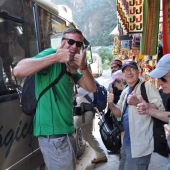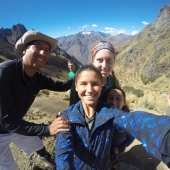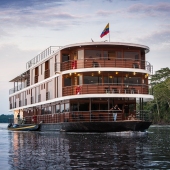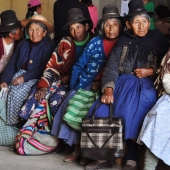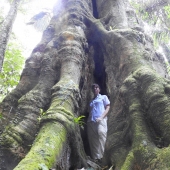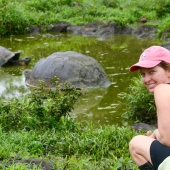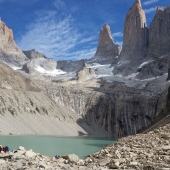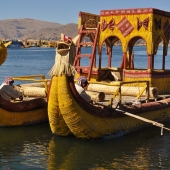
How to Train for Machu Picchu Treks
As a leading provider of Machu Picchu small group tours and treks, the staff at Adios Adventure Travel understand that while having the proper clothing, equipment and hiking accessories is important for hiking the Inca Trail, the most beneficial thing hikers can do is to make sure each member of your group is in adequate physical condition. You don't have to be a super athlete, but knowing your limitations is useful. Trekking several hours a day, for multiple days in a row at high altitude is challenging for even the most seasoned hikers.
We're here to provide information to help you get ready for an amazing experience in the high-altitude land of the llamas! Our staff have hiked all the Inca Trails in Peru and we have first-hand information to help you prepare. And it's free! The info that is. Hiking the trails should be enjoyable — with a smidge of suffering — which is why your fitness is worth paying attention to. I've been doing crossfit for over 10 years. Now in my 60s, I am quite able to participate in hikes and activities in remote regions in South America. But everyone, even me, have limits which we need to pay attention to.
To begin training for high altitude hikes, focus on your body and your mind:
- practice hiking 2-4 times a month, or more, for several hours at a time, even if it's at sea level.
- participate in regular cardiovascular exercise including interval training or sustained, vigorous running, biking, swimming or crossfit
- try to do at least some light weightlifting (or pave your driveway, chop some firewood or rotate your tires)
- test your “mind over matter" skills by pushing through a challenging physical activity of your choice.
Need help preparing for your hike in Peru?
If first impressions count, I liked this website so much, I called Marcus at FITFORTRIPS.COM to ask questions about how his website training works. I was pleasantly surprised and encouraged enough to include the link to his website here in case someone out there is interested. If you need a boost or motirvation or helpful strategies, give it a try. I would love to get your feedback about your experience. Let me know how it works out for you.
How High is the Altitude on the Inca Trail
Depending on which Inca Trail you hike, (we can help you choose the right trail) the altitude varies from around 9,000 ft. above sea level, which is considered low by Peruvian standards, up to 14,000 ft at Dead Woman's Pass. (we promise you will not see any bodies as you cross over the pass!) Hiking with reduced oxygen in the air you breathe puts strain on your entire body, making even normal physical activities more challenging. Most travelers come from sea level and everyone has to deal with the same issues.
Vidal and I designed a multi-day itinerary that begins in Cusco with time to acclimatize to the altitude, enjoy easy day hikes, and includes the option to add the short 1 Day Inca Trail hike to Machu Picchu.
7-Day Machu Picchu Walking Vacation is perfect for active travelers of all ages.
For groups who want the option of hiking the strenuous 4-day Inca Trail or taking the train, we created a "3-in-1" itinerary for groups of any size.
8-Day Machu Picchu Trip For Groups is perfect for multi-generation families or groups of mixed ages and abilities.
How to begin your fitness workouts for high altitude hiking:
- if you haven't been exercising regularly, talk to your medical advisor before you begin.
- use the act of booking the hike as your motivation to begin your exercise program. At least 3-6 months in advance.
- if you have a gym, ask if they have an oxygen deprivation mask you can borrow to mimic breathing with less air. (and less oxygen)
- work up to exercise at least an hour while wearing a weighted vest or backpack with 20 lbs. or more.
- strengthen your diaphragm with respiratory exercises. It's the secret to performing your best at high altitude. (Link to Outside Magazine)
- exercise 2-3 days in a row to increase your endurance and recovery, and teach your brain to hike even when you're tired.
- treadmills and stairclimbers can be useful if you also wear your heavier hiking footwear, a weight vest, and workup to using the incline feature eventually to the max setting.
Cardio Training for Hikes in Peru
The Inca built steep trails and switchbacks with lofty stone steps all over the Andes Mountains. Perfect terrain for a llama! But for human lowlanders accustomed to breathing oxygen-rich air at sea level, it's a challenge to hike in these conditions. Even if you're not hiking, traveling in Peru is a great way to maintain fitness because of the amount of walking it takes to get around.
Tips to start a regimen to intensify your cardiovascular fitness before you travel to Peru:
- Choose a cardio activity you enjoy so you're more likely to do it.
- Set up a schedule you know you can keep.
- Invite a friend to join you.
- Start out slow. And build. Don't stop!
- Join a gym or find a local coach to help get your started.
How can you train to hike at high altitude in the Andes Mountains if you're coming from sea level?
Not that it's any comfort, but the majority of visitors who go to Machu Picchu are coming from the lowlands. One strategy to improve fitness, especially for people coming from sea level, is to work out, exercise, or engage in strenuous physical activity for 2-3 days back to back. This forces you to keep moving several days in a row. Your body (and your brain) learn to recover overnight and get ready to move through sore muscles or stiff joints the next day. It's one thing to work out for a day then rest for several days. But we recommend that you challenge yourself to push into 2-3 days of vigorous exercise and pay attention to getting adequate overnight rest.
Should Kids Hike the Inca Trail? Yes!
Here's a link to our parent checklist to help you decide if your kids should hike.
Is there anything you can bring to benefit you during the Inca Trail hikes?
Understanding what you can do to mitigate your weaknesses should be part of your overall strategy. If you know your "weak" ankles and your "bum" knees might act up, bring a brace and OTC pain relievers. Test out your treatments at home before you travel. If your bum knee doesn't recover with support braces or pain meds you might need to see a medical specialist to make sure there's nothing to prevent you from enjoying the hike. Use the right shoes. They can be high, mid or low tops depending on your preference. Just make sure they're sturdy and have grippy soles.
Did you know you can get custom fitted for a comfortable backpack for your Inca Trail Hike?
The backpacks your kids used in school and now banished to the bottom of the dusty closet may not be the most comfortable equipment. If you plan to hike again, it might be time to invest in a new backpack. Or ask outdoorsy friends and family if you can borrow theirs. Here's a link to one of our short videos on Youtube for all you visual learners!
Some travelers will ask their doctor about bringing a prescription for DIAMOX (acetazolamide). Meds may help take the edge off but they don't work for everyone. In order to get the benefit you have to start taking them 1-2 days before you arrive at altitude.
What areas should you focus your training for high altitude hiking in Peru?
- strengthen your diaphragm muscles to improve your efficiency to breath at altitude
- stamina - to train yourself to keep pushing even when you are tired
- core strength - for carrying backpack all day and maintaining your balance
- leg strength - for walking on uneven and rough terrain
- mind - to train yourself to reinforce your good habits and how to push through your perceptions of your physical limits
- recovery - learn what helps you bounce back after exertion
- descent - this is worth mentioning because you think it would be easy. But it's very demanding on the joints. We provide trekking poles for those people who ask in advance
People who should not hike the Inca Trail:
- if you're pregnant (not that you can't, but there is limited access to medical services, so we don't want you to go)
- anyone who has difficulty walking on any terrain. Everyone should be able to walk on rough cobbled trails, uneven steep stone steps and steep inclines.
- anyone who cannot carry at least a small backpack for a full day (avg 20-30 lbs)
- anyone who thinks they're out of shape. You probably are. Can you get in shape? Yes. Will you get in shape? If you're not sure, don't book this hike.
Use the months leading up to your trip to test your fitness and your limits. After you arrive in Peru, Adios guides will meet with you the day before your hike to answer your last minute questions. If they have any worries about your ability to complete the hike they will not allow you to begin the hike. The reason for this is because it's not possible to begin the hike then turn around and go back. And there are no roads for vehicles. Once you start the hike, your only option is to continue to the end. On rare occasions, a hiker decides to walk the train tracks, which are flat, instead of hiking the trail. The train will not stop to pick you up. You will hike all the way to Aguas Calientes.
If you’re interested in hiking in Peru with Adios Adventure Travel, contact us today!
Disclaimer: I am not a medical professional and recommend that you consult your medical advisor before beginning any exercise program or before engaging in new physical activities.


